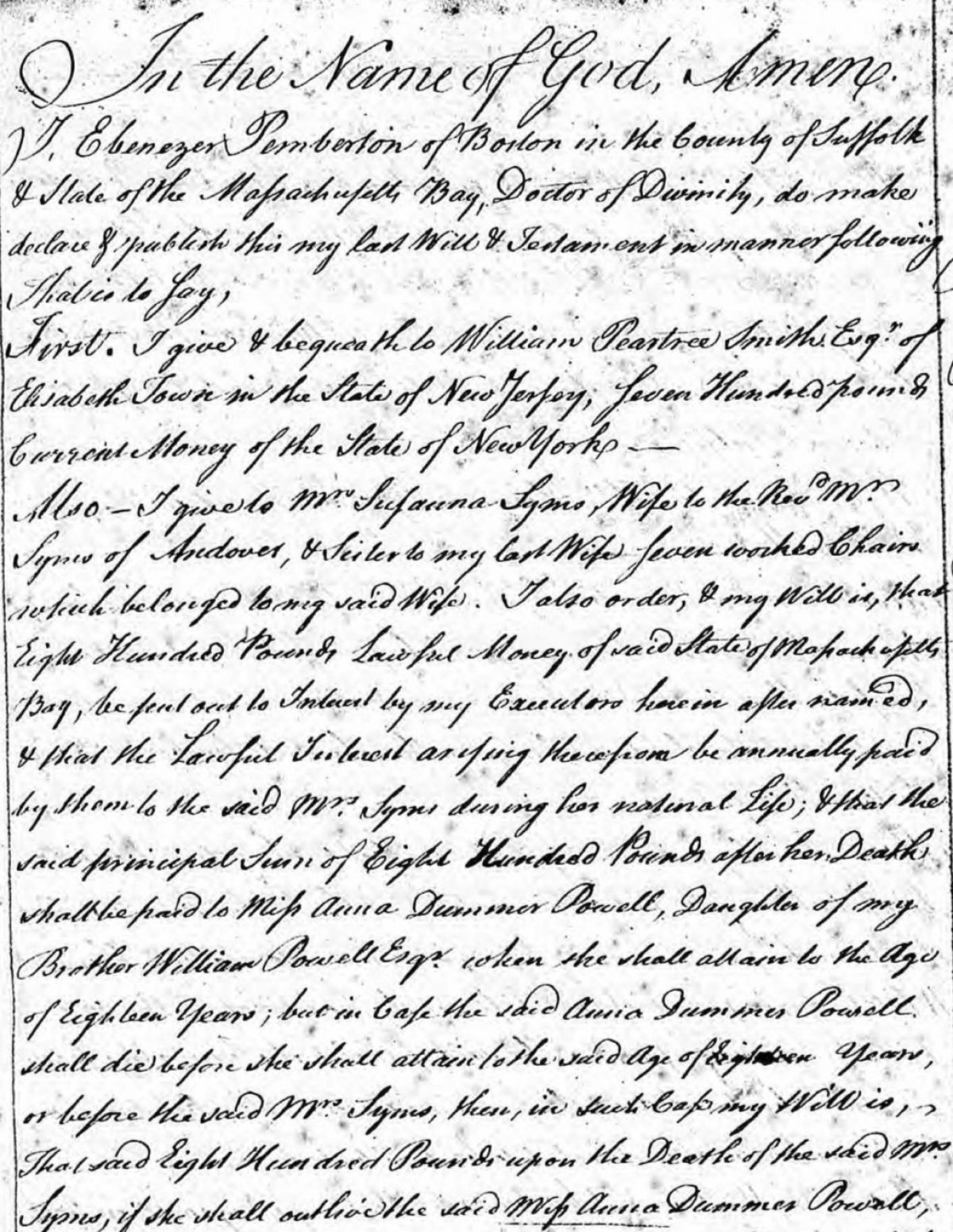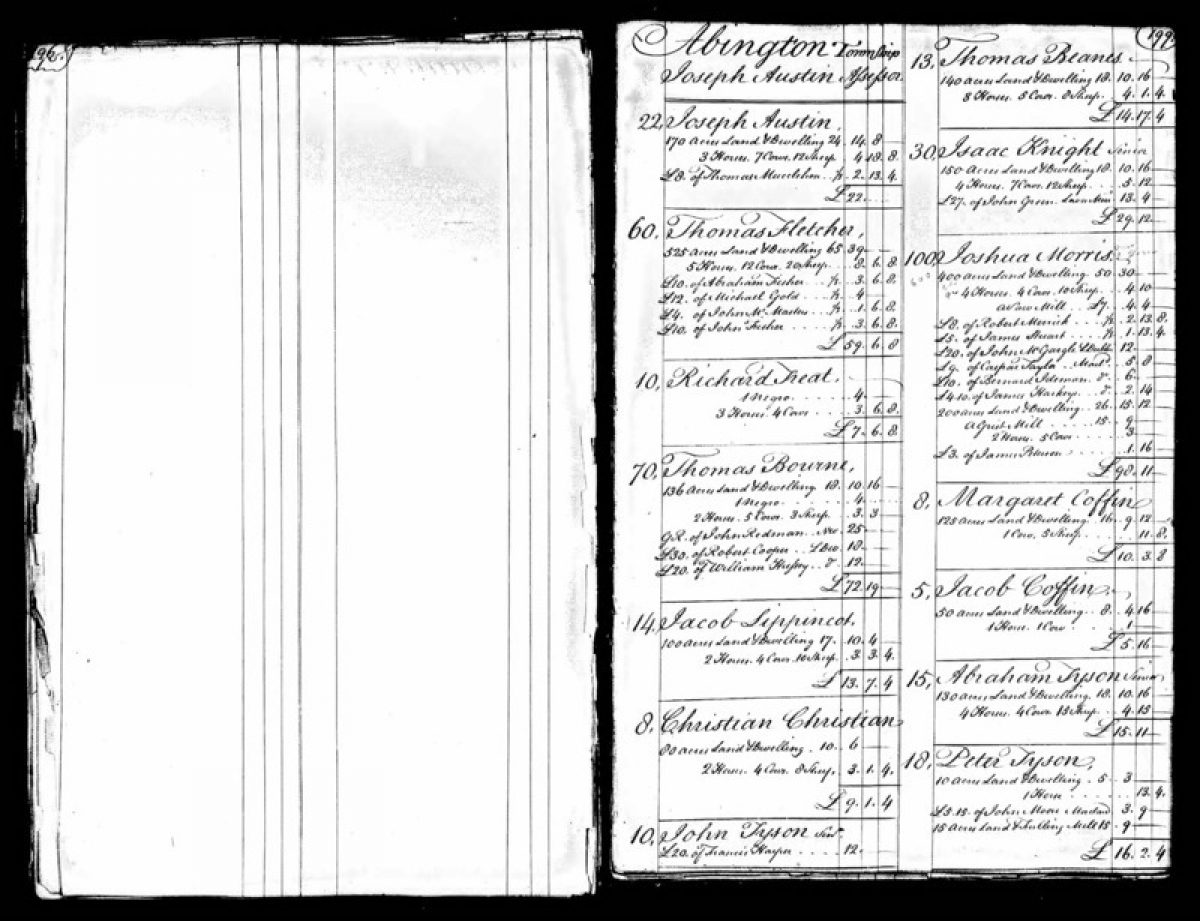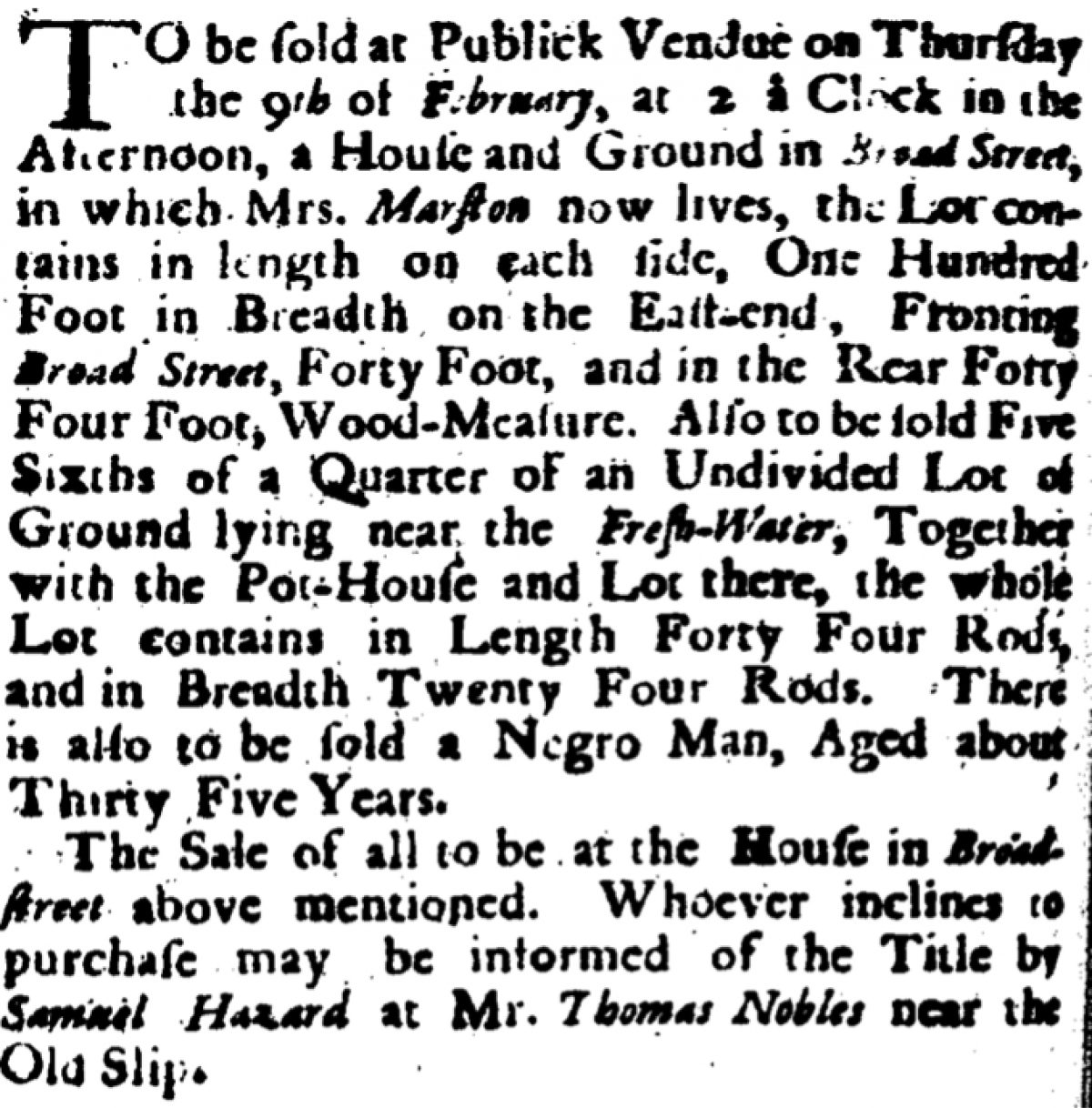[1]
On how the Great Awakening led to the founding of Princeton University, see: Thomas Jefferson Wertenbaker, Princeton, 1746-1896 (Princeton, NJ: Princeton University Press, 1946), 1-47.
⤴
[3]
[No Headline], Philadelphia Gazette, 13 August 1747, 3.
⤴
[4]
Jonathan Dickinson signed the 1746 charter, but passed away in October 1747. Samuel Finley was added to the charter in 1747, but he was not included in the 1748 charter.
⤴
[5]
Bill of Sale for Jonathan Dickinson’s purchase of Genny, June 9, 1733, in Anson Phelps Stokes, Memorials of Eminent Yale Men: A Biographical Study of Student Life and University Influences During the Eighteenth and Nineteenth Centuries (New Haven, CT: Yale University Press, 1914), 196.
⤴
[6]
Jonathan Dickinson, “Directions for Walking with God,” in Familiar Letters to a Gentleman Upon a Variety of Seasonable and Important Subjects in Religion (Edinburgh: Printed by William Gray, 1757): 442-443. Interestingly, in the 1799 reprint of the sermons, the word “slave” was changed to “servant.” See Jonathan Dickinson, Familiar Letters to a Gentleman Upon a Variety of Seasonable and Important Subjects in Religion (London: Religious Tract Society, 1799), 338.
⤴
[7]
S. Scott Rohrer, Jacob Green’s Revolution: Radical Religion and Reform in a Revolutionary Age (University Park, PA: Pennsylvania State University Press, 2014), 210.
⤴
[8]
[No Headline], advertisement, New-York Gazette, 28 August 1758, 4.
⤴
[9]
James Pemberton, Probate No. 2338, Wills and Probate Records, Massachusetts County, Vol. 10-12, 1687-1697, p. 226, accessed 17 July 2017, www.ancestry.com. On the Pemberton family, see Walter K. Watkins, The Pemberton Family (Boston: David Clapp & Son, 1892).
⤴
[10]
“Rev. Ebenezer Pemberton’s Will,” No. 16385, District and Probate Records, Massachusetts County, Vol. 76-77, 1777-1778, p. 412, accessed 17 July 2017, www.ancestry.com.
⤴
[11]
On the Livingston family, see: Cynthia A. Kierner, Traders and Gentlefolk: The Livingstons of New York, 1675-1790 (Ithaca, NY: Cornell University Press, 1992); James G. Lydon, “New York and the Slave Trade, 1700 to 1774,” The William and Mary Quarterly 35:2 (April 1978), 375-394; Craig Steven Wilder, Ebony and Ivy: Race, Slavery, and the Troubled History of America’s Universities (New York: Bloomsbury Press, 2013), 52-53, 66-69. For a useful overview slavery in New York City, see Ira Berlin and Leslie M. Harris, Slavery in New York (New York: The New Press, 2005).
⤴
[12]
Wilder, Ebony and Ivy, 68.
⤴
[13]
Bill of sale reprinted in Milton Meltzer, Slavery: A World History (Boston: Da Capo, 1993), 142.
⤴
[14]
Wertenbaker, Princeton, 1746-1896, 21.
⤴
[15]
[No Headline], Philadelphia Gazette, 13 August 1747, 3.
⤴
[16]
Gary B. Nash, Forging Freedom: The Formation of Philadelphia’s Black Community, 1720-1840 (Cambridge, MA: Harvard University Press, 1988), 19-22; Gideon Mailer, "Between Enlightenment and Evangelicalism: Presbyterian Diversity and American Slavery, 1700-1800," in Faith and Slavery in the Presbyterian Diaspora, ed. William Harrison Taylor and Peter C. Messer (Bethlehem, PA: Lehigh University Press, 2016), p. 54.
⤴
[17]
Richard Treat, Tax Lists, Reel 74, p. 199, in Historic Pennsylvania Church and Town Records, Historical Society of Pennsylvania, accessed 17 July 2017, www.ancestry.com.
⤴
[18]
[No Headline], The New-York Mercury, 4 August 1766, 3.
⤴
[19]
Will of Samuel Blair, Pennsylvania, Wills and Probate Records, 1683-1993, p. 296, accessed 17 July 2017, www.ancestry.com. There is no mention of slaves in Samuel Blair’s will; however, that alone does not eliminate the possibility that there may be evidence of slaves elsewhere. The research for this piece has consisted solely of a digital search of newspaper databases, GoogleBooks, and HaithiTrust, as well as a search of the records digitized through www.ancestry.com. More extensive research of Samuel Blair’s personal records is needed may indeed uncover evidence of slaveholding.
⤴
[20]
Wertenbaker, Princeton, 1746-1896, 27.
⤴
[21]
The full list of the trustees named in the 1748 charter is printed in John Maclean, History of the College of New Jersey: From Its Origin in 1746 to the Commencement of 1854, Volume I (Philadelphia: J.B. Lippincott & Co., 1877), 91.
⤴
[22]
For Jonathan Belcher, see: Wilder, Ebony and Ivy, 15-17; Alexandra A. Chan, Slavery in the Age of Reason: Archaeology at a New England Farm (Knoxville, TN: University of Tennessee Press, 2007), 47. For John Reading, see: David R. Reading, “Gov. John Reading (1686-1767),” Lecture presented to the Hunterdon County Historical Society, March 29, 2009, p. 16, accessed 17 July 2017, http://www.mtamwell.org/GovJohnLectureFinalReviewed.pdf. For Thomas Leonard, see: [No Headline], advertisement, The New-York Mercury, 13 , 3. For Edward Shippen, see: Will Books C-D, 1771-1784, p. 203, Pennsylvania Wills and Probate Records, accessed at www.ancestry.com. For Samuel Hazard, see: [No Headline], May 1765; The New-York Gazette, 7 February 1738, 4. For David Cowell, see: Graham Russell Hodges and Alan Edward Brown, "Pretends to Be Free": Runaway Slave Advertisements from Colonial and Revolutionary New York and New Jersey (New York: Garland Publishing, 1994), 287-88. For Jacob Green, see: Rohrer, Jacob Green’s Revolution, 210. For the following trustees named in the 1748 charter, no evidence of slaveholding has been found: Thomas Arthur, James Hude, Andrew Johnston, Timothy Jones, John Kinsey, and Joseph Lamb.
⤴
[23]
It must be emphasized that just because this study found no evidence of slaveholding for six of the 1748 trustees, it does not necessarily mean they did not hold slaves during their life; it only means no evidence is immediately available through digital sources. Evidence about slaveowning is notoriously difficult to track down. For instance, in regard to 1748 trustee John Kinsey, one historian writes: “[We] suspect that at least some of the others for whom there is no evidence (such as John Kinsey) [owned slaves] as well.” See Jean R. Soderlund, Quakers and Slavery: A Divided Spirit (Princeton, NJ: Princeton University Press, 1985), 40.
⤴
[24]
Rohrer, Jacob Green’s Revolution, 210. For more on Green’s abolitionism, see David Mitros, Jacob Green and the Slavery Debate in Revolutionary Morris County, New Jersey (Morris County, NJ: The Morris County Heritage Commission, 1993).
⤴
[25]
Wilder, Ebony and Ivy, 114.
⤴
[26]
Wertenbaker, Princeton, 1746-1896, 24-25.
⤴
[27]
Bryan F. Le Beau, Jonathan Dickinson and the Formative Years of American Presbyterianism (Lexington, KY: The University Press of Kentucky, 1997), 2
⤴
[28]
Ibid., 25-47. The land on which Nassau Hall now stands was donated by Nathaniel Fitz Randolph. For record of Fitz Randolphs’s slaveholding, see: [No Headline], advertisement, The New York Mercury, 13 May 1765, 2.
⤴









